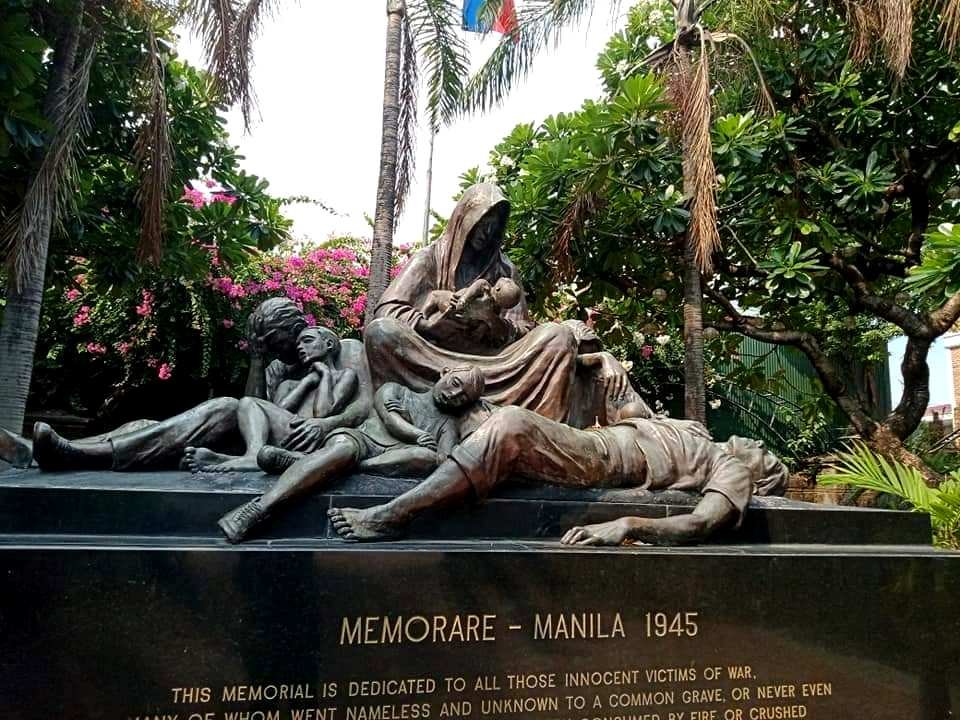𝗙𝗹𝗼𝘄𝗲𝗿𝘀 𝗳𝗼𝗿 𝗟𝗼𝗹𝗮𝘀 𝗯𝘆 𝗔𝘁𝘁𝘆. 𝗗𝗲𝗻𝗻𝗶𝘀 𝗚𝗼𝗿𝗲𝗰𝗵𝗼
“The non-combatant victims of that tragic battle will remain forever in the hearts and minds of the Filipino people”.
This is part of the inscription penned by Nick Joaquin, National Artist for Literature, on the “Memorare Manila 1945 Monument” that can be found in Plaza de Sta. Isabel at the corner of General Luna and Anda Streets, Intramuros, Manila, which is a short walk from the Manila Cathedral and the San Augustine Church.

Made by sculptor Peter de Guzman, the monument serves as a “gravestone” reminder of the dark years of Manila that commemorates the lives lost during the battle for the liberation of Manila waged by Filipino and American forces against Imperial Japanese troops from February 3 to March 3, 1945.
The monument was unveiled on February 18, 1995 with its main feature of the figure of a hooded woman slumped on the ground in great despair for the lifeless child she cradles in her arms along with six suffering figures surrounding her.
The inscription states: “This monument is erected in memory of the more than 100,000 defenseless civilians who were killed during the Battle for the Liberation of Manila between February 3 and March 3, 1945. They were mainly victims of heinous acts perpetrated by the Japanese Imperial Forces and the casualties of the heavy artillery barrage by the American Forces. The Battle for Manila at the end of World War II was one of the most brutal episodes in the history of Asia and the Pacific. The non-combatant victims of that tragic battle will remain forever in the hearts and minds of the Filipino people”.
Subjected to incessant pounding and facing certain death or capture, the beleaguered Japanese troops took out their anger and frustration on the civilians caught in the crossfire, committing multiple acts of severe brutality.
The Japanese forced Filipino women and children to be used as human shields into the frontlines to protect Japanese positions. Those who survived were then murdered by the Japanese.
The bodies of people, even babies — beheaded, mutilated, bayoneted and shot — littered the streets, schools, public buildings, even places of worship.
Also known as the Rape of Manila, the city became one of the most devastated Allied capital cities during the entire war, alongside Berlin and Warsaw as Japanese resistance and American artillery destroyed much of Manila’s architectural and cultural heritage dating back to the city’s founding.
“In a war, everybody is a loser. Nobody is a winner. But we should also look at how we used our wisdom as a people to help liberate ourselves from the Japanese and see that the triumphant Filipino can overcome even the worst tragedies,” historian Xiao Chua said.
After the simple commemoration rites last February 17, 2024, a forum was held at the nearby Bahay Tsinoy Museum entitled “RECOLLECTIONS”. Survivors shared memories and experiences during wartime Manila which “sadly, hardly anyone remembers”.
Teresita Ang See of Flowers for Lolas noted that victims of atrocities under the Japanese occupation include the Filipina comfort women.
About 200,000 women from Korea, China, Burma, New Guinea, and the Philippines were held in captivity and many thousands more were raped as part of one of the largest operations of sexual violence in modern history.
The girls were abducted, trafficked, or brought to the Japanese military camps. The victims spent their lives in misery, having endured physical injuries, pain and disability as well as mental and emotional suffering.
According to testimony at the Yamashita war crimes trial, the Bayview Hotel was used as a designated “rape center”. Some 400 women and girls were rounded up from Manila’s wealthy Ermita District and submitted to a selection board that picked out the 25 women who were considered most beautiful. They were then taken to the hotel where Japanese enlisted men and officers took turns raping them.
A four-meter Lola statue, wearing a traditional Filipino dress, blindfolded, with hands clutched to her chest, was installed along Roxas Boulevard on December 8, 2017.
However, the statue was dismantled on April 27, 2018 by the DPWH, allegedly for a drainage improvement project, but it was seen as a submission to protests from Japan. It was later declared missing when its artist, Jonas Roces, failed to turn over the statue during its scheduled reinstallation on August 25, 2019.
The UN Committee on the Elimination of Discrimination against Women (CEDAW) released on International Women’s Day, March 8, 2023, a decision on the complaint by the Malaya Lolas, which found that the “Philippines violated the rights of victims of sexual slavery perpetrated by the Imperial Japanese Army during the Second World War by failing to provide reparation, social support and recognition commensurate with the harm suffered”.
Let us #neverforget the Rape of Manila.
(𝐴𝑡𝑡𝑦. 𝐷𝑒𝑛𝑛𝑖𝑠 𝑅. 𝐺𝑜𝑟𝑒𝑐ℎ𝑜 ℎ𝑒𝑎𝑑𝑠 𝑡ℎ𝑒 𝑠𝑒𝑎𝑓𝑎𝑟𝑒𝑟𝑠’ 𝑑𝑖𝑣𝑖𝑠𝑖𝑜𝑛 𝑜𝑓 𝑡ℎ𝑒 𝑆𝑎𝑝𝑎𝑙𝑜 𝑉𝑒𝑙𝑒𝑧 𝐵𝑢𝑛𝑑𝑎𝑛𝑔 𝐵𝑢𝑙𝑖𝑙𝑎𝑛 𝑙𝑎𝑤 𝑜𝑓𝑓𝑖𝑐𝑒𝑠. 𝐹𝑜𝑟 𝑐𝑜𝑚𝑚𝑒𝑛𝑡𝑠, 𝑝𝑙𝑒𝑎𝑠𝑒 𝑒𝑚𝑎𝑖𝑙 𝑖𝑛𝑓𝑜@𝑠𝑎𝑝𝑎𝑙𝑜𝑣𝑒𝑙𝑒𝑧.𝑐𝑜𝑚, 𝑜𝑟 𝑐𝑎𝑙𝑙 09175025808 𝑜𝑟 09088665786)














